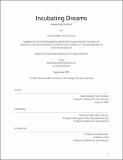| dc.contributor.advisor | Pattie Maes. | en_US |
| dc.contributor.author | Haar Horowitz, Adam Jedidiah. | en_US |
| dc.contributor.other | Program in Media Arts and Sciences (Massachusetts Institute of Technology) | en_US |
| dc.date.accessioned | 2020-03-23T20:45:30Z | |
| dc.date.available | 2020-03-23T20:45:30Z | |
| dc.date.copyright | 2019 | en_US |
| dc.date.issued | 2019 | en_US |
| dc.identifier.uri | https://hdl.handle.net/1721.1/124208 | |
| dc.description | This electronic version was submitted by the student author. The certified thesis is available in the Institute Archives and Special Collections. | en_US |
| dc.description | Thesis: S.M., Massachusetts Institute of Technology, School of Architecture and Planning, Program in Media Arts and Sciences, 2019 | en_US |
| dc.description | Cataloged from student-submitted PDF version of thesis. | en_US |
| dc.description | Includes bibliographical references (pages 159-169). | en_US |
| dc.description.abstract | This research centers on the question of whether interfacing with dreams can help us explore and augment the creative potential of our minds. The dreaming experience at sleep onset, called hypnagogia, is the main focus of this thesis: these first minutes of sleep provide ideal conditions for incubating specific dream content and recalling it after awakening. This thesis presents Dormio, an interactive system which uses biometric-based audio interaction in hypnagogia to incubate and capture sleep onset dreams. Dormio incubates specific dream themes; allows for multiple bouts of hypnagogia in one nap session; has automated capture of dream reports; and enables users to explore phenomenology at adjustable levels of consciousness. Dormio further augments human creativity, benefitting both objective and subjective ratings on a battery of creative performance metrics including Creative Self-Efficacy, Creative Storytelling Task, Alternative Uses Task and Verb Generation Task. Both the hypnagogic state and specific hypnagogic content confer creative benefits, suggesting a causal effect of dream content on creativity. The incubation of dreams has fascinated people for millennia, yet reliable protocols have proved elusive. Dormio offers a mobile and inexpensive protocol, enabling controlled experimentation on all the ways in which nightly dreams help construct daily cognition. Understanding sleep onset allows us to understand the mechanisms that bridge daytime and nighttime thought, consciousness and unconsciousness. Understanding creative boosts in hypnagogia allows us to understand cognitive flexibility across the sleep-wake cycle, from how we see ourselves to how others see us. Understanding devices which go beyond design for daytime to interface across levels of consciousness opens a broad swath of possibilities for interacting with humans as we truly are -- thinkers on a 24 hour cycle. | en_US |
| dc.description.statementofresponsibility | by Adam Jedidiah Haar Horowitz. | en_US |
| dc.format.extent | 169 pages | en_US |
| dc.language.iso | eng | en_US |
| dc.publisher | Massachusetts Institute of Technology | en_US |
| dc.rights | MIT theses are protected by copyright. They may be viewed, downloaded, or printed from this source but further reproduction or distribution in any format is prohibited without written permission. | en_US |
| dc.rights.uri | http://dspace.mit.edu/handle/1721.1/7582 | en_US |
| dc.subject | Program in Media Arts and Sciences | en_US |
| dc.title | Incubating dreams : awakening creativity | en_US |
| dc.type | Thesis | en_US |
| dc.description.degree | S.M. | en_US |
| dc.contributor.department | Program in Media Arts and Sciences (Massachusetts Institute of Technology) | en_US |
| dc.identifier.oclc | 1145278388 | en_US |
| dc.description.collection | S.M. Massachusetts Institute of Technology, School of Architecture and Planning, Program in Media Arts and Sciences | en_US |
| dspace.imported | 2020-03-23T20:45:30Z | en_US |
| mit.thesis.degree | Master | en_US |
| mit.thesis.department | Media | en_US |
